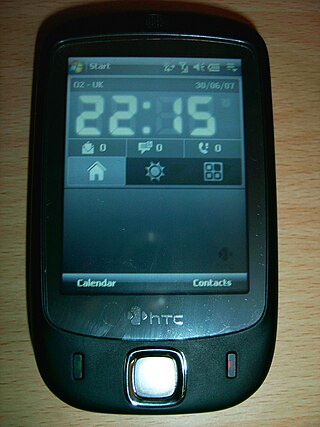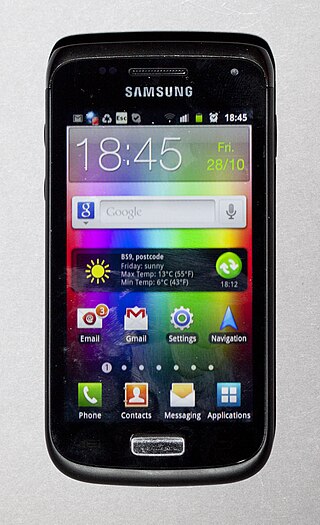The O2 Xda brand was a range of Windows Mobile PDA phones, marketed by O2, developed by O2 Asia and manufactured by multiple OEMs (mainly HTC, Quanta and Arima). The first model was released in June 2002. The last models came to market in 2008. The "X" represents convergence of voice and information/data within one product; the "DA" stands for "Digital Assistant", as in PDA. The name of XDA Developers is derived from it.

The HTC Touch, also known as the HTC P3450 or its codename the HTC Elf or the HTC Vogue for the CDMA variant, is a Windows Mobile 6-powered Pocket PC designed and manufactured by HTC. Its main, unique feature is a user interface named TouchFLO that detects a sweeping motion and can distinguish between a finger and a stylus. TouchFLO incorporates stylus-free access to a music player, a photo album, a video player and a picture-based contact book. The global launch of the Touch was in Leicester Square, London, on 5 June 2007, and the phone was initially available in two colours: black and green. The carrier bound names for this phone include Verizon Wireless XV6900, T-Mobile MDA Touch, O2 XDA Nova, Okta Touch and Vodafone VPA Touch.

TouchFLO 3D is a graphical user interface designed by HTC. It is used in the HTC Touch Family of Pocket PCs and was preceded by TouchFLO. TouchFLO 3D has been ported to Windows Mobile and Android, and is used in the HTC Touch Diamond, HTC Touch Pro, HTC Touch HD, HTC MAX 4G, HTC Touch Diamond2 and HTC Touch Pro2. The HTC Touch Viva, HTC Touch 3G and HTC Touch2 have a simpler version entitled TouchFLO 2D, where they have the same scrolling tab on the bottom of the screen, however they do not have any 3D visual effects. From the HTC Hero and HTC HD2 onwards, TouchFLO 3D has been heavily extended and is now being referred to, along with other usability improvements, as HTC Sense. The HTC Touch2 runs a version of TouchFLO 2D that is similar in style to HTC Sense.
The HTC Touch family was a family of Pocket PCs designed and manufactured by HTC Corporation. Its slogan was Discover Touchnology.

The HTC Dream is a smartphone developed by HTC. First released in October 2008 for $179 with a 2-year contract to T-Mobile, the Dream was the first commercially released device to use the Linux-based Android operating system, which was purchased and further developed by Google and the Open Handset Alliance to create an open competitor to other major smartphone platforms of the time, such as Symbian, BlackBerry OS, and iPhone OS. The operating system offers a customizable graphical user interface, integration with Google services such as Gmail, a notification system that shows a list of recent messages pushed from apps, and Android Market for downloading additional apps. This operating system's debut would later be followed by the Samsung Galaxy i7500, the first in what would become the long-running Samsung Galaxy series.

The HTC Touch HD, also known as the HTC T828X or its codename the HTC Blackstone, is a Windows Mobile 6.1 Pocket PC designed and manufactured by HTC launched in 2008.

HTC Sense is a software suite developed by HTC, used primarily on the company's Android-based devices. Serving as a successor to HTC's TouchFLO 3D software for Windows Mobile, Sense modifies many aspects of the Android user experience, incorporating additional features, additional widgets, re-designed applications, and additional HTC-developed applications. The first device with Sense, the HTC Hero, was released in 2009. The HD2 running Windows Mobile 6.5, released later the same year, included Sense. Following the release of the Hero, all future Android devices by HTC were shipped with Sense, except for the Nexus One, the Desire Z, the HTC First, the Google Pixel and Pixel 2, and the Nexus 9 which used a stock version of Android. Also some HTC smartphones that are using MediaTek processors come without HTC Sense.
The HTC Tattoo is a phone manufactured by the HTC Corporation for the Android platform. It is the second phone to feature the HTC Sense interface. The phone was announced on 8 September 2009.

The HTC HD2, is a smartphone in the HTC Touch family designed and manufactured by HTC. The HD2 natively runs the Windows Mobile 6.5 operating system, and was released in Europe in November 2009, in Hong Kong in December 2009, and in other regions including North America in March 2010. The phone is the successor to the HTC Touch HD, and is succeeded by the HTC HD7.

The HTC Desire is the first smartphone of the Desire series developed by HTC. It was announced on 16 February 2010 and released in Europe and Australia in the second quarter of the same year. The HTC Desire was HTC's third flagship phone running Android 2.1 Eclair which can be upgraded to 2.2 Froyo or 2.3 Gingerbread. Internally it bears a strong resemblance to the Nexus One, but differs in some features.

The HTC Evo 4G is a smartphone developed by HTC Corporation and marketed as Sprint's flagship Android smartphone, running on its WiMAX network. The smartphone was launched on June 4, 2010. It was the first 4G enabled smartphone released in the United States.

The HTC Aria is a smartphone manufactured by HTC Corporation that runs the Android operating system with HTC Sense.

The HTC Desire HD is an Android smartphone by HTC Corporation. It was unveiled at a press event in London hosted by HTC on September 15, 2010, and was made available for sale in October in Europe and in January 2011 in Canada. The Desire was HTC's fourth flagship Android device until the release of their new line of flagship model, the HTC Sensation.

The HTC HD7, is a smartphone running the Windows Phone OS operating system. The phone was designed and manufactured by HTC. It is the successor to the HTC HD2, and it has a special variant which is the HTC HD7S.
The T-Mobile myTouch 4G is a smartphone designed and manufactured by HTC Corporation for T-Mobile USA's "myTouch" re-branded series of phones. HTC's name for the device during development was "Glacier". This is T-Mobile's second "4G" phone, after the T-Mobile G2, and the third smartphone by T-Mobile that runs Android 2.2 Froyo software. The phone was released in black, red, and white colors.

The T-Mobile myTouch 4G Slide is a touchscreen slider smartphone designed and manufactured by HTC Corporation for T-Mobile USA's "myTouch" series of phones. It is the fourth of the myTouch family. The myTouch 4G Slide is the first myTouch to feature HTC Espresso 3.0, a graphical user interface similar to HTC Sense 3.0. Highlights include an 8-megapixel camera, the Genius Button, and a hardware keyboard.

Samsung Galaxy W (i8150), also known as Samsung Wonder, is an Android smartphone that is a smaller-sized variant of Samsung Galaxy S II.

HTC One is a touchscreen-based Android smartphone designed, developed, and manufactured by HTC. The smartphone was unveiled on 19 February 2013 at press events in New York City and London and is HTC's seventh flagship smartphone. It has been hailed by many as a revolutionary Android handset with its premium design and build quality and its emphasis on high end audio. It is the successor to the company's 2012 flagship model, the One X—which was critically acclaimed, but commercially unsuccessful due in part to insufficient marketing efforts. To make the device stand out among its competition, HTC One was developed with a major emphasis on unique hardware and software features; which included a unibody aluminum frame, a 1080p full-HD display, dual front-facing stereo speakers, a camera with a custom image sensor and the ability to automatically generate montages of media, an updated version of HTC's Sense user experience, BlinkFeed—an aggregator of news and social network content, and an electronic program guide app with the ability to serve as a universal remote via an IR blaster located in the device's power button.
A lock screen is a computer user interface element used by various operating systems. They regulate immediate access to a device by requiring the user to perform a certain action in order to receive access, such as entering a password, using a certain button combination, or performing a certain gesture using a device's touchscreen. There are various authentication methods to get past the lock screen, with the most popular and common ones being personal identification numbers (PINs), the Android pattern lock, and biometrics.
The HTC Desire 601 is an Android smartphone designed and manufactured by HTC. The Desire 601 is a mid-range device carrying design traits from the HTC One and One Mini, utilizing a dual-core processor, 4.5-inch qHD display, and offering LTE support.














